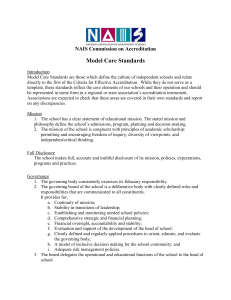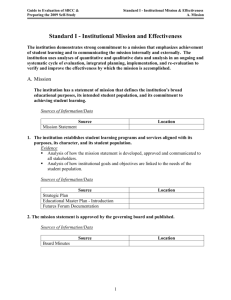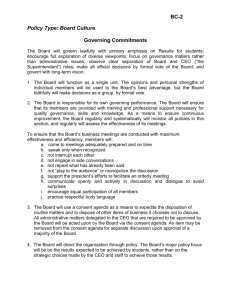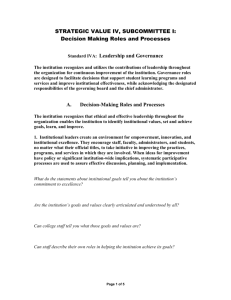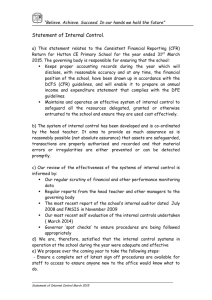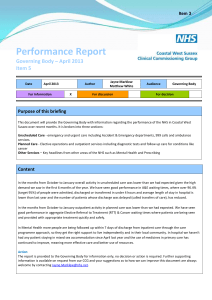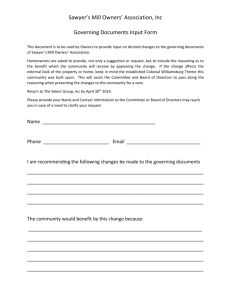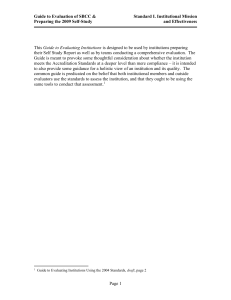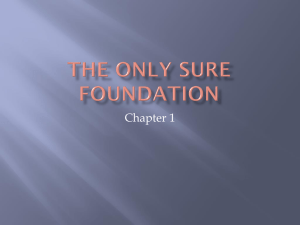Excerpt from “Evaluating Institutions”
advertisement
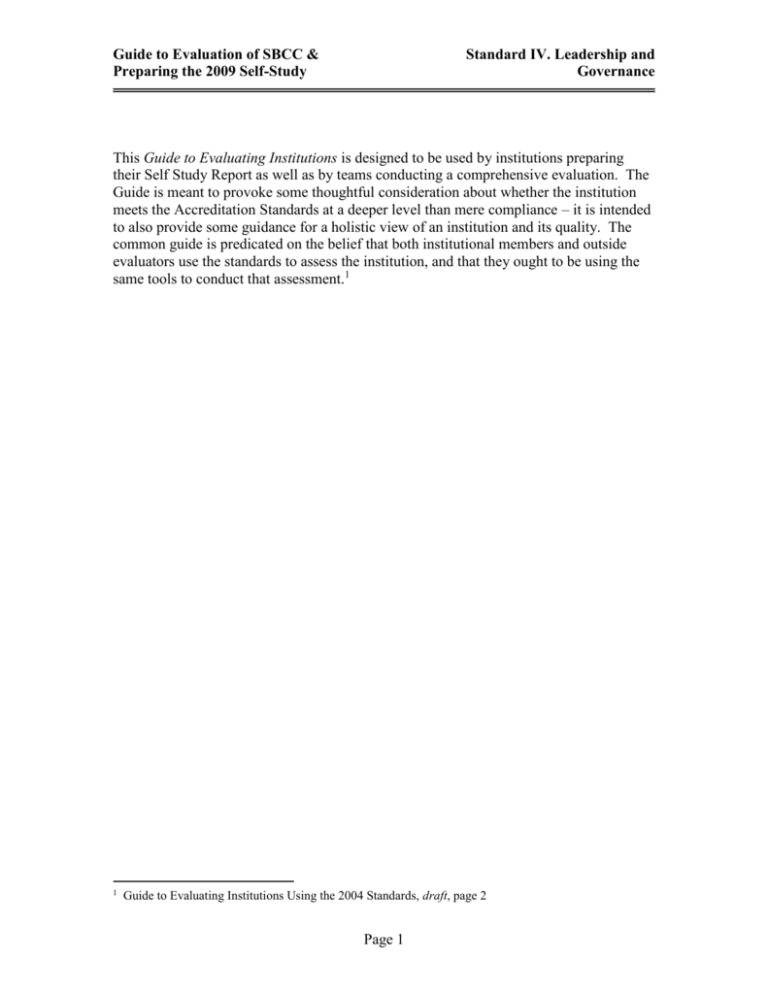
Guide to Evaluation of SBCC & Preparing the 2009 Self-Study Standard IV. Leadership and Governance This Guide to Evaluating Institutions is designed to be used by institutions preparing their Self Study Report as well as by teams conducting a comprehensive evaluation. The Guide is meant to provoke some thoughtful consideration about whether the institution meets the Accreditation Standards at a deeper level than mere compliance – it is intended to also provide some guidance for a holistic view of an institution and its quality. The common guide is predicated on the belief that both institutional members and outside evaluators use the standards to assess the institution, and that they ought to be using the same tools to conduct that assessment.1 1 Guide to Evaluating Institutions Using the 2004 Standards, draft, page 2 Page 1 Guide to Evaluation of SBCC & Preparing the 2009 Self-Study Standard IV. Leadership and Governance A. Decision-making Roles & Processes Excerpt from “Guide to Evaluating Institutions”2 A. Decision-making Roles and Processes Std # Questions 1. 2. 3. 4. 5. 6. 7. A.1 8. 9. 10. 11. 12. 11. A.2.a 12. A.2.b 2 What do the statements about institutional goals tell you about the institution’s commitment to excellence? Are the institution’s goals and values clearly articulated and understood by all? Can college staff tell you what those goals and values are? Can staff describe their own roles in helping the institution achieve its goals? What information about institutional performance is circulating and available to staff and students? Is the information kept current? Is it easily accessed, is it understandable? Is it regularly used in institutional discussions and decision-making sessions? Do the institution’s processes for institutional evaluation and review, and planning for improvements, provide venues where the evaluations of the institution’s performance are made available to all staff? Do institutional planning efforts provide opportunity for appropriate staff participation? How do individuals bring forward ideas for institutional improvement? How does the institution articulate the responsibilities of individuals to develop ideas for improvements in their areas of responsibility? How do individuals and groups at the institution use the governance process to enhance student learning? What do institutional policies and procedures describe as the roles for each group in governance, including planning and budget development? What documents describe the official responsibilities and authority of the faculty and of academic administrators in curricular and other educational matters? Ibid., 53-55 Page 2 Guide to Evaluation of SBCC & Preparing the 2009 Self-Study A.3 A.4 A.5 Standard IV. Leadership and Governance A. Decision-making Roles & Processes 13. Do the written policies on governance procedures specify appropriate roles for all staff and students? 14. Do these policies specify the academic roles of faculty in areas of student educational programs and services planning? 15. Are staff and students well informed of their respective roles. Do staff participate as encouraged by these policies? 16. Do the various groups work in collaborative effort on behalf of institutional improvements? 17. Is the result of this effort actual institutional improvement? 18. Is there effective communication at the college – clear, understood, widely available, current communication? 19. Do staff at the college know essential information about institutional efforts to achieve goals and improve learning? 20. What does documentation of the institution’s past accreditation history show about integrity in its relationship with the commission – has it responded expeditiously and honestly to recommendations, are there citations indicating difficulty, etc.? 21. Are the institution’s communications of institutional qualities or effectiveness to the public accurate? 22. What is the institution’s track record in its relationship with the U.S. Department of Education? 23. What process does the institution use to evaluate its governance and decision-making structures? 24. Are the results communicated within the campus community? 25. Does the institution identify weaknesses and make needed improvements? Page 3 Guide to Evaluation of SBCC & Preparing the 2009 Self-Study Standard IV. Leadership and Governance B. Board and Administrative Organization B. Board and Administrative Organization3 B.1 B.1.a B.1.b B.1.c B.1.d & e B.1.f B.1.g B.1.h 3 26. Does the institution have a Policy Manual or other compilation of policy documents that show the Board’s role in establishing said policy and reviewing it on a regular basis? 27. What statements about quality of program, integrity of institutional actions, and about effectiveness of student learning programs and services are to be found in the institution’s board-established policies, mission statement, vision or philosophy statement, planning documents, or other statements of direction? 28. What is the written policy describing selection of the chief administrator? Has the board followed it or another process? 29. Is the governing board appropriately representative of the public interest and lacking conflict of interest. 30. Are less that half of Board members owners of the institution? 31. Are a majority of governing board members non owners of the institution? 32. Does the composition of the governing board reflect public interest in the institution? 33. What policies, institutional goals or other formal statements exist that describe Board expectations for quality, integrity and improvement of student learning programs and services? 34. Is the governing board independent – are its actions final, not subject to the actions of any other entity? 35. Do the records of Board actions (minutes, resolutions) indicate that it acts consistent with its policies and bylaws? 36. Does the Board have a system for evaluating and revising its policies on a regular basis? Is this system implemented? 37. What is the board’s system for development and orientation? 38. Does the Board development system address the board’s need to learn about accreditation standards and expectations? 39. Does the Board have a formal, written method of providing for continuing membership and staggered terms of office? 40. What is the board self evaluation process as defined in its policies? 41. Does that process as described likely to be an effective review? 42. Does the policy call for regular self-evaluation? 43. Does the institution’s board regularly evaluate its own performance? 44. What is the Board’s stated process for dealing with board behavior that is unethical? 45. Is there any track record of the board implementing this process? 46. What was the result? Ibid, 55-61 Page 4 Guide to Evaluation of SBCC & Preparing the 2009 Self-Study B.1.i B.1.j Standard IV. Leadership and Governance B. Board and Administrative Organization 47. What kinds of training are provided to the Board about the accreditation process, its standards? 48. How does the Board participate appropriately in institutional selfstudy and planning efforts? 49. How do board actions, including planning and resource allocation, indicate a commitment to improvements planned as part of institutional self-evaluation and accreditation processes? 50. How do Board actions reflect the commitment to supporting and improving student learning outcomes as reflected in the accreditation standards and expectations for institutional improvement? 51. Is the Board informed of institutional reports due to the Commission, of Commission recommendations to the institution? 52. Is the Board knowledgeable about accreditation standards, including those that apply to the Board? 53. Does the Board assess its own performance using accreditation standards? 54. What is the established Board process for conducting search and selection processes for the chief administrator? 55. Are those processes written? 56. Has the Board used these processes in its most recent searches? 57. How is the Board delegation of administrative authority to the chief administrator defined? In policy documents? In a contract with the chief administrator? 58. Is this delegation clear to all parties? 59. How effective is the Board in remaining focused at the policy level? 60. What mechanisms does the board use in its evaluation of the chief administrator’s performance on implementation of board policies and achievement of institutional goals? 61. How does the Board set clear expectations for regular reports form the chief administrator on institutional performance? 62. How does the Board set expectations for sufficient information on institutional performance to insure that it can fulfill its responsibility for educational quality, legal matters, and financial integrity? Page 5 Guide to Evaluation of SBCC & Preparing the 2009 Self-Study B.2.a & b B.2.c - e Standard IV. Leadership and Governance B. Board and Administrative Organization 63. What does the president do to communicate institutional values, goals and direction? 64. How familiar is the president with data and analyses of institutional performance. 65. How does the president communicate the importance of a culture of evidence and a focus on student learning? 66. Where does the research office report in the institution – does it have easy access to the President’s office? 67. What mechanisms has the president put in place to link institutional research, particularly research on student learning, institutional planning processes, resource allocation processes? 68. How does the district chief executive officer follow the component parts of this standard in the role of providing effective district leadership? No questions provided in the Guide. Page 6 Guide to Evaluation of SBCC & Preparing the 2009 Self-Study Standard IV. Leadership and Governance Standard Language Standard IV: Leadership and Governance The institution recognizes and utilizes the contributions of leadership throughout the organization for continuous improvement of the institution. Governance roles are designed to facilitate decisions that support student learning programs and services and improve institutional effectiveness, while acknowledging the designated responsibilities of the governing board and the chief administrator. A. Decision-Making Roles and Processes The institution recognizes that ethical and effective leadership throughout the organization enables the institution to identify institutional values, set and achieve goals, learn, and improve. 1. Institutional leaders create an environment for empowerment, innovation, and institutional excellence. They encourage staff, faculty, administrators, and students, no matter what their official titles, to take initiative in improving the practices, programs, and services in which they are involved. When ideas for improvement have policy or significant institution-wide implications, systematic participative processes are used to assure effective discussion, planning, and implementation. 2. The institution establishes and implements a written policy providing for faculty, staff, administrator, and student participation in decision-making processes. The policy specifies the manner in which individuals bring forward ideas from their constituencies and work together on appropriate policy, planning, and special-purpose bodies. a. Faculty and administrators have a substantive and clearly defined role in institutional governance and exercise a substantial voice in institutional policies, planning, and budget that relate to their areas of responsibility and expertise. Students and staff also have established mechanisms or organizations for providing input into institutional decisions. b. The institution relies on faculty, its academic senate or other appropriate faculty structures, the curriculum committee, and academic administrators for recommendations about student learning programs and services. 3. Through established governance structures, processes, and practices, the governing board, administrators, faculty, staff, and students work together for the good of the institution. These processes facilitate discussion of ideas and effective communication among the institution’s constituencies. Page 7 Guide to Evaluation of SBCC & Preparing the 2009 Self-Study Standard IV. Leadership and Governance Standard Language 4. The institution advocates and demonstrates honesty and integrity in its relationships with external agencies. It agrees to comply with Accrediting Commission standards, policies, and guidelines, and Commission requirements for public disclosure, selfstudy and other reports, team visits, and prior approval of substantive changes. The institution moves expeditiously to respond to recommendations made by the Commission. 5. The role of leadership and the institution’s governance and decision-making structures and processes are regularly evaluated to assure their integrity and effectiveness. The institution widely communicates the results of these evaluations and uses them as the basis for improvement. B. Board and Administrative Organization In addition to the leadership of individuals and constituencies, institutions recognize the designated responsibilities of the governing board for setting policies and of the chief administrator for the effective operation of the institution. Multi-college districts/systems clearly define the organizational roles of the district/system and the colleges. 1. The institution has a governing board that is responsible for establishing policies to assure the quality, integrity, and effectiveness of the student learning programs and services and the financial stability of the institution. The governing board adheres to a clearly defined policy for selecting and evaluating the chief administrator for the college or the district/system. a. The governing board is an independent policy-making body that reflects the public interest in board activities and decisions. Once the board reaches a decision, it acts as a whole. It advocates for and defends the institution and protects it from undue influence or pressure. b. The governing board establishes policies consistent with the mission statement to ensure the quality, integrity, and improvement of student learning programs and services and the resources necessary to support them. c. The governing board has ultimate responsibility for educational quality, legal matters, and financial integrity. d. The institution or the governing board publishes the board bylaws and policies specifying the board’s size, duties, responsibilities, structure, and operating procedures. e. The governing board acts in a manner consistent with its policies and bylaws. The board regularly evaluates its policies and practices and revises them as necessary. f. The governing board has a program for board development and new member orientation. It has a mechanism for providing for continuity of board membership and staggered terms of office. g. The governing board’s self-evaluation processes for assessing board performance are clearly defined, implemented, and published in its policies or bylaws. Page 8 Guide to Evaluation of SBCC & Preparing the 2009 Self-Study Standard IV. Leadership and Governance Standard Language h. The governing board has a code of ethics that includes a clearly defined policy for dealing with behavior that violates its code. i. The governing board is informed about and involved in the accreditation process. j. The governing board has the responsibility for selecting and evaluating the district/system chief administrator (most often known as the chancellor) in a multi-college district/system or the college chief administrator (most often known as the president) in the case of a single college. The governing board delegates full responsibility and authority to him/her to implement and administer board policies without board interference and holds him/her accountable for the operation of the district/system or college, respectively. In multi-college districts/systems, the governing board establishes a clearly defined policy for selecting and evaluating the presidents of the colleges. 2. The president has primary responsibility for the quality of the institution he/she leads. He/she provides effective leadership in planning, organizing, budgeting, selecting and developing personnel, and assessing institutional effectiveness. a. The president plans, oversees, and evaluates an administrative structure organized and staffed to reflect the institution's purposes, size, and complexity. He/she delegates authority to administrators and others consistent with their responsibilities, as appropriate. b. The president guides institutional improvement of the teaching and learning environment by the following: • establishing a collegial process that sets values, goals, and priorities; • ensuring that evaluation and planning rely on high quality research and analysis on external and internal conditions; • ensuring that educational planning is integrated with resource planning and distribution to achieve student learning outcomes; and • establishing procedures to evaluate overall institutional planning and implementation efforts. c. The president assures the implementation of statutes, regulations, and governing board policies and assures that institutional practices are consistent with institutional mission and policies. d. The president effectively controls budget and expenditures. e. The president works and communicates effectively with the communities served by the institution. Page 9

